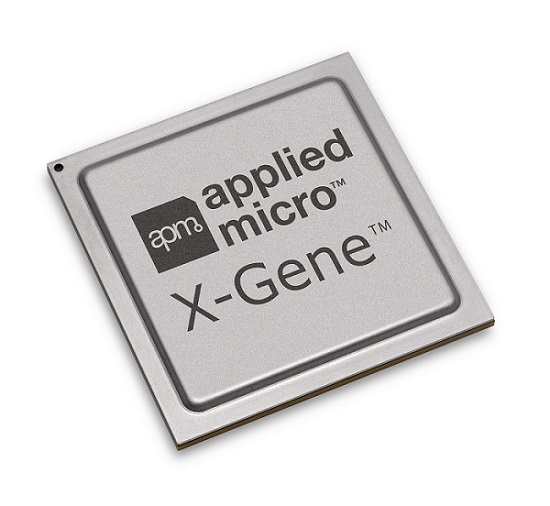The new chip from Applied Micro is ready to contend with Intel Xeon
Applied Micro announced the distribution of X-Gene 3 samples, systems on a chip for servers on the third-generation ARM architecture. According to the Linley Group report, the new platform will provide comparable performance with the latest Intel Xeon processors for a significantly lower price.

Applied Micro, which is now part of the semiconductor manufacturing company MACOM, officially introduced X-Gene 3 in November last year, but this week it became known about the distribution of sample chips and delivery to customers, which means that their free sale will begin in this year In addition to Applied Micro / MACOM, new developments on the ARM architecture in 2017 will also put on the market Cavium and Qualcomm, ThunderX2 and Centriq 2400 SoCs processors, respectively.

The X-Gene 3 scheme. The processor contains 32 cores, 32MB L3 cache, eight DDR4-2667 DRAM channels and 42 PCI Express Gen3 lines.
A comparative analysis of these technologies with each other and with the current leader of Intel Xeon server processors was carried out in the latest report by Linley Gwennap, chief analyst at The Linley Group and editor-in-chief of Microprocessor Report. Gwennap believes that the new X-Gene will handle the cloud computing workloads as well or even better than Xeon, as is the case with some high-performance computing applications. The new Applied Micro platform for performance is named in the study leader.
The X-Gene 3's performance is the result of its relatively high clock speed and memory bandwidth. The processor runs on 32 cores with a base frequency of 3.0 GHz and can reach 3.3 GHz in turbo mode. The chip includes eight memory channels that can serve DDR4 devices with frequencies up to 2667 MHz, providing a bandwidth of 170 GB / s. The on-chip system also includes 42 PCIe 3.0 lanes for external connections.
According to Gwennap, this led to several impressive performance indicators. From the report:
"Based on testing the current configuration of the 3.0 GHz and DDR4-2400 processor frequency, we can expect the chip to provide a SPECint_rate2006 (peak) score of at least 500 when operating at a maximum speed of 3.3 GHz and DDR4-2667 and with some additional hardware software and compiler. This indicator is far ahead of that of any other ARM processor and is similar to that of the main Xeon E5 processors. ”
A tabular comparison with comparable Intel Xeon processors is shown below:

Comparative table of the characteristics of high-power server processors. X-Gene 3 has obvious advantages in memory bandwidth, not yielding to everything else.
Gwennap concludes that existing publicly available Xeons with more cores or higher clock speeds than the E5-2680 will work better than X-Gene 3. But these are high-end chips that cost more than $ 2,000 and are not aimed at cloud computing market or corporate client that Applied Micro is counting on.
As for the ARM competition, Gwennap claims that X-Gene 3 is able to overtake both the latest version of the Cantium ThunderX2 SoC and the new Centriq 2400 chip from Qualcomm. Although the performance of the ThunderX2 core per core should improve significantly, this model will not compete with the more productive X-Gene 3. Also, Gwennap suggests that the Qualcomm offer will have similar ThunderX2 performance, although he admits that less is known about his technical capabilities.
The report also states that X-Gene 3 can handle "a wide range of cloud workloads, including application scaling." It should be especially well adapted for so-called. big data applications (such as in-memory database processing) due to its excellent bandwidth. Coincidentally (but is this a coincidence?), AMD is announcing the release of its new Naples x86 chip for very similar tasks on the same 8-channel circuit.
Important caveat: X-Gene 3 does not compete with Xeon in terms of performance in floating-point tasks, and this gap will only widen with the advent of Skylake AVX-enabled processors. This, however, does not apply to HPC applications. As one of the examples in the study, some types of bioinformatics applications that mainly use scalar processing are cited. But for high performance computing workloads, X-Gene 3 will have to rely on a graphics processor or other floating point accelerator to provide competitive performance.
There is nothing surprising in achieving comparable performance with Intel Xeon, but Applied Micro believes that it will be able to make a very profitable offer for the server processor market. Although the specific pricing policy of X-Gene 3 has not yet been made public, they are likely to cut the cost of the Xeon E5-2680 at $ 1,745 by a third. Other manufacturers of ARM chips will also try to compete with Intel. That, in turn, can always reduce its prices or offer other financial incentives to reduce this difference in value.
Which, apparently, she will have to use. Given the competition with the AMD processor entering the market, Intel is likely to have to cut margins on Xeon products in order to maintain market share. In addition, Microsoft recently demonstrated its work with Cavium and Qualcomm on creating ARM-based servers for their own data centers. The idea is to partially deploy them in the companies, and partly in the Azure cloud. If the Microsoft gambit turns out to be profitable, then soon we will all witness how many people will move to the ARM servers. It will be a pleasure to follow the most interesting dynamics of the market, with all the moves and counter-moves between all these chip makers, which will unfold in the next 12 months.
')
Source: https://habr.com/ru/post/325022/
All Articles